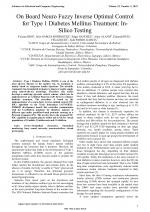| 3/2022 - 1 | View TOC | « Previous Article | Next Article » |
| Extra paper information in |
| Click to see author's profile in |
| Download PDF |
Author keywords
biomedical electronics, biomedical monitoring, fuzzy neural networks, neurocontrollers, virtual prototyping
References keywords
control(39), diabetes(29), systems(16), optimal(15), sanchez(13), neural(13), inverse(12), type(10), fuzzy(9), networks(7)
Blue keywords are present in both the references section and the paper title.
About this article
Date of Publication: 2022-08-31
Volume 22, Issue 3, Year 2022, On page(s): 3 - 14
ISSN: 1582-7445, e-ISSN: 1844-7600
Digital Object Identifier: 10.4316/AECE.2022.03001
Web of Science Accession Number: 000861021000001
SCOPUS ID: 85137729315
Abstract
Type 1 Diabetes Mellitus (T1DM) is one of the most adverse diseases in the modern era; its treatment is mainly based on exogenous insulin injections. The scientific community has formulated strategies to improve insulin supply using state-of-the-art technology. Therefore, this article develops a multi-age glycemic control scheme, which can be implemented in an Artificial Pancreas (AP) device to enhance diabetics treatment. The procedure is based on the implementation of a neuro-fuzzy inverse optimal control (NF-IOC) algorithm on the Texas Instrument LAUNCHXL-F28069M development board; this controller communicates with the Uva/Padova simulator for diabetics' patients of different ages under predefined meal protocols running on a Personal Computer (PC). The novelty lies in the proposed NF-IOC capability to regulate glucose within safe levels for virtual populations of 10 adults, 10 adolescents and, 10 children. |
| References | | | Cited By |
Web of Science® Times Cited: 0
View record in Web of Science® [View]
View Related Records® [View]
Updated today
SCOPUS® Times Cited: 0
View record in SCOPUS® [Free preview]
There are no citing papers in the CrossRef Cited-by Linking system.
Disclaimer: All information displayed above was retrieved by using remote connections to respective databases. For the best user experience, we update all data by using background processes, and use caches in order to reduce the load on the servers we retrieve the information from. As we have no control on the availability of the database servers and sometimes the Internet connectivity may be affected, we do not guarantee the information is correct or complete. For the most accurate data, please always consult the database sites directly. Some external links require authentication or an institutional subscription.
Web of Science® is a registered trademark of Clarivate Analytics, Scopus® is a registered trademark of Elsevier B.V., other product names, company names, brand names, trademarks and logos are the property of their respective owners.
Faculty of Electrical Engineering and Computer Science
Stefan cel Mare University of Suceava, Romania
All rights reserved: Advances in Electrical and Computer Engineering is a registered trademark of the Stefan cel Mare University of Suceava. No part of this publication may be reproduced, stored in a retrieval system, photocopied, recorded or archived, without the written permission from the Editor. When authors submit their papers for publication, they agree that the copyright for their article be transferred to the Faculty of Electrical Engineering and Computer Science, Stefan cel Mare University of Suceava, Romania, if and only if the articles are accepted for publication. The copyright covers the exclusive rights to reproduce and distribute the article, including reprints and translations.
Permission for other use: The copyright owner's consent does not extend to copying for general distribution, for promotion, for creating new works, or for resale. Specific written permission must be obtained from the Editor for such copying. Direct linking to files hosted on this website is strictly prohibited.
Disclaimer: Whilst every effort is made by the publishers and editorial board to see that no inaccurate or misleading data, opinions or statements appear in this journal, they wish to make it clear that all information and opinions formulated in the articles, as well as linguistic accuracy, are the sole responsibility of the author.





